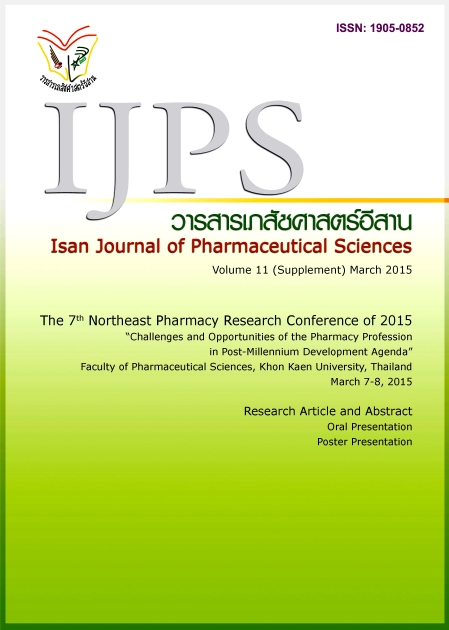Development of gummy jelly from Makmao (Antidesma velutinosum Blume) crude extract
Main Article Content
Abstract
Introduction: Makmao (Antidesma velutinosum Blume) is a small fruit with red or purple color. It is one of the plants commonly used for health benefits. Makmao contains Anthocyanins, Flavonoids and Polyphenols that are responsible for antioxidant activity. The purpose of this study was to prepare a gummy jelly product of Makmao extraction obtaining from a suitable solvent. The products were then tested on their characteristics. Materials and Methods: Three different solvents, namely 95% ethanol, 50% ethanol and water were used for Makmao extraction. The extract which provided the highest amount of anthocyanin, polyphenol and flavonoid was carried out to develop gummy jelly product. In the preparation, gelatin was used as gelling agent. The obtained products were determined physical appearance, chemical and microbiological activities. Results: Makmao extraction using 95% Ethanol as a solvent had the highest % yield compared to other solvents. Moreover, it revealed the significant amount of anthocyanin, polyphenol and flavonoid contents (p<0.05). Makmao gummy jelly having 10% gelatin had a lower water activity than that of 15% gelatin. Results from texture analyzer showed that firmness and chewiness of 10% gelatin gummy jelly product were low in comparison to the product prepared by 15% gelatin. Furthermore, microorganisms and heavy metals were not observed in the products. Conclusion: Ethanolic extraction of Makmao containing high amount of active compounds is able to prepare gummy jelly product and it might be used to develop further health products.
Article Details
In the case that some parts are used by others The author must Confirm that obtaining permission to use some of the original authors. And must attach evidence That the permission has been included
References
AOAC. Total Monomeric Anthocyanin Pigment Content of Fruit Juices, Beverages, Natural Colorants, and Wines. J. AOAC Int 2005; 88(5): 1269-1278.
Chang CC, Yang MH, Wen HM, Chern JC, Estimation of total flavonoid content in propolis by two complementary colorimetric methods, JFDA 2002; 10: 178-182.
Deepanya W. Development of gummy jelly Tamarind product. Project report of Phetchabun Rajabhat University 2008.
Judprasong K, Charoenkiatkul S, Thiyajai P, Sukprasansap M. Nutrients and bioactive compounds of Thai indigenous fruits. Food Chem. 2013; 140: 507–512.
Marinova D, Ribarova F, Atanassova M. Total phenolics and total flavonoids in Bulgarian fruit and vegetables. J. Chem. Technol. Metall. 2005; 40: 255-260.
Maisuthisakul P, Sutthajit M, Pongsawatmanit R. Assessment of phenolic content and free radical-scavenging capacity of some Thai indigenous plants. Food Chem. 2005; 100(2007): 409-418.
Meesang S, Wuttijumnong P, Pongsawatmanit R, Chenputhi S. Effect of gelatin sucrose/ glucose syrup ratio and citric acid on physical properties and sensory quality of gummy jelly product. Kasetsart University Conference No.41st; 2003 Feb 3-7; Bangkok, Thailand. Kasetsart University; 2003.
Nuengchamnong N, Ingkaninan K. On-line HPLC-MS-DPPH assay for the analysis of phenolic antioxidant compounds in fruit wine: Antidesma thwaitesianum Muell. Food Chem. 2010; 118(2010): 147-152.
Ovando AC, Pacheco-Hernández MDL, Hernández P, Rodríguez JA, Galán-Vidal CA. Chemical studies of anthocyanins. Food Chem. 2009; 113: 859–871.
Schrieber R, Gareis H. Gelatine Handbook: Theory and Industrial Practice. Weinheim: Wiley-VCH; 2007.
Slingkard K, singleton VL. Total phenal analysis: automation and comparison with manual method. AJEV 1977; 28: 49-55.


